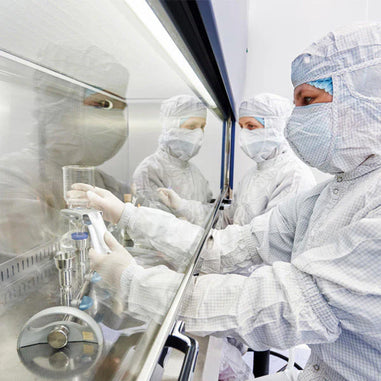- No products in the cart.
Centrifugation is a critical technique used in laboratories to separate components of mixtures based on their density. The efficiency of this process greatly depends on the proper use of centrifuge tubes. These tubes, which come in various sizes, materials, and types, are specifically designed to withstand the forces generated during centrifugation. Maximizing efficiency in their use can significantly enhance the accuracy and reliability of your results. Here are some best practices for using centrifuge tubes effectively.
1. Choosing the Right Centrifuge Tubes
The first step to maximizing efficiency is selecting the appropriate centrifuge tubes for your specific application. Consider the following factors:
-
Material: Centrifuge tubes are typically made from plastic (such as polypropylene or polyethylene) or glass. Plastic tubes are preferred for most biological applications because they are less likely to break under high-speed centrifugation and are generally more chemically resistant. Glass tubes, on the other hand, are suitable for certain chemical applications where chemical resistance is paramount.
-
Size and Volume: Choose tubes that match the volume of your sample. Using tubes that are too large can lead to inefficient centrifugation, while tubes that are too small might not accommodate the entire sample.
-
Closure Type: Ensure the tubes have appropriate closures (caps or plugs) to prevent spillage or evaporation during centrifugation. Snap caps are common for biological samples, while screw caps provide a more secure seal for chemical samples.
2. Proper Loading and Balancing
Correct loading and balancing of centrifuge tubes are crucial for safe and efficient centrifugation:
-
Equal Volumes: Always ensure that the tubes contain equal volumes of sample. Even small discrepancies can lead to imbalances that cause the centrifuge to vibrate excessively or even fail.
-
Opposite Positions: When placing tubes in the centrifuge rotor, always position them directly opposite each other to maintain balance. If you have an odd number of tubes, balance them with an appropriate counterweight.
-
Tube Orientation: Place tubes in the rotor with the caps facing outward. This minimizes the risk of leaks and ensures optimal separation of the sample components.
3. Centrifuge Settings and Maintenance
Optimizing centrifuge settings and regular maintenance are vital for achieving the best results:
-
Speed and Time: Set the centrifuge to the recommended speed (revolutions per minute, RPM) and duration for your specific application. Over-centrifugation can cause sample degradation, while under-centrifugation may result in incomplete separation.
-
Temperature Control: Some samples are sensitive to temperature changes. Use a refrigerated centrifuge or ensure the laboratory environment is controlled to prevent heat buildup during prolonged centrifugation.
-
Routine Maintenance: Regularly inspect and maintain your centrifuge. Check for rotor wear and tear, clean the chamber and rotor, and ensure the lid and safety mechanisms function correctly. A well-maintained centrifuge performs more reliably and extends the lifespan of your equipment.
4. Sample Preparation and Handling
Proper sample preparation and handling can significantly enhance centrifugation efficiency:
-
Pre-Centrifugation Preparation: Ensure samples are well-mixed before loading them into centrifuge tubes. This helps achieve uniformity in the separation process.
-
Avoid Overfilling: Do not fill tubes beyond their recommended capacity. Overfilled tubes can cause spillage, leading to cross-contamination and inaccurate results.
-
Labeling and Documentation: Clearly label each centrifuge tube to avoid mix-ups and document the centrifugation parameters used for each sample. This practice ensures traceability and reproducibility in your experiments.
5. Post-Centrifugation Handling
Careful handling of samples after centrifugation is essential to maintain the integrity of the separated components:
-
Slow Deceleration: If your centrifuge has the option, use slow deceleration to prevent disturbance of the separated layers. Abrupt stopping can cause remixing of the sample components.
-
Gentle Removal: Carefully remove the tubes from the centrifuge without tilting or shaking them. This minimizes the risk of disturbing the pellet and supernatant.
-
Immediate Analysis: Whenever possible, proceed with further analysis or processing of the samples immediately after centrifugation to prevent degradation or evaporation of sensitive components.
6. Safety Considerations
Always prioritize safety when using centrifuge tubes:
-
Inspect Tubes: Before each use, inspect centrifuge tubes for cracks, chips, or other damage. Damaged tubes can break during centrifugation, posing a hazard.
-
Wear Protective Gear: Always wear appropriate personal protective equipment (PPE), such as lab coats, gloves, and safety goggles, to protect against potential spills or breakages.
-
Follow Protocols: Adhere to your laboratory's safety protocols and the manufacturer's guidelines for the centrifuge and tubes. Proper training and adherence to protocols ensure a safe working environment.
Conclusion
Maximizing efficiency in the use of centrifuge tubes involves a combination of selecting the right tubes, proper loading and balancing, optimizing centrifuge settings, and careful sample handling. By following these best practices, you can enhance the accuracy and reliability of your centrifugation results, ensuring successful and reproducible outcomes in your laboratory work. Remember, efficient centrifugation is not just about the equipment but also about the techniques and practices you employ.
For over 45 years, Lab Pro Inc. is your steadfast source for lab centrifuge tubes, cleanroom lab supplies, hand tools, lab equipment, chemicals, and PPE apparel. Trusted by aerospace industries, medical device companies, and laboratories globally, we epitomize exceptional quality in every product. Experience the convenience of next day service in California. Contact us online or at 888-452-2776 to explore solutions tailor-made for the laboratory industry. Elevate your experiments with Lab Pro Inc. – your partner in precision and excellence.



















































